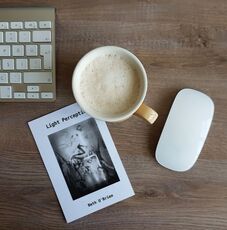 I am two weeks into my Creative Writing MA. I am enjoying it a lot and survived my first round of feedback on my writing from my fellow students! As usual, I’ve been thinking a lot about how I write disability in the stories I come up with. But during my Thursday evening class, I realised that there is something interesting in hearing others pick up on how and what I describe. The character in the story I wrote was not stated to have any disability and (perhaps naturally) everyone assumed her to be able bodied. Here is an extract from my story: In the distance, she can make out a cluster of colours. It stays still for the most part, but as she watches, a solitary figure breaks away. Masie hangs back at a socially acceptable distance and together, although they do not know it, she and the huddle watch the figure step towards the iron railings. The class pointed out that it is not clear that the cluster of colours is a group of people, and that they only began to guess that it was a group of people when the figure stepped away. In my head, I was thinking, 'Well, yes, obviously' because this is exactly how I work out the world. Nine times out of ten, I use location and context and movement to guess what it is I am seeing. So, yes, I’d have seen a bundle of colours ahead, I would have tried to notice specifics, would have failed, and would have used the movement and the distinct shape of the single human to guess that the bundle of colours was more people. Another point they had was that I peppered my description with spots of colour, homing in on certain specifics while giving very sparse detail about other things. Again, I have a tiny field of vision. I see the very thing I am focusing on with almost no peripheral. I found it really interesting to hear all of this, because I have never noticed (how would I?!) that I write in this way, and why this might create unnecessary confusion for sighted readers. I’m not saying anyone should have guessed whether or not the character had a visual impairment – it wasn’t the point of the story. I’m also not saying that my way of writing did not deserve those comments, because they are totally valid and I had no idea I wrote in this way! I just think it was a really interesting thing to note, and a really good example of the different perspectives a disability lens can give a piece of writing. Thank you for reading my ramble – I’m happy and eager to hear any questions or thoughts you might have on this!
2 Comments
 A little while ago, the lovely humans at Wild Pressed Books asked if I'd do a poetry reading for their new YouTube channel. A couple of days ago, I sat down to record, holding my little poetry pamphlet, Light Perception. The pamphlet is all about visual impairment, disability, and the struggle to appear able. It was not long until I realised the irony of my pretending to be reading aloud from the pamphlet, when in reality, I took a couple of moments to memorise the poems I wanted to read, as I am definitely too blind to read the font in the actual book. I could have probably read from the book itself if I had held it uncomfortably close to my face. Instead, I had a closer look off-camera, and used the shape of the poem on the page, and the length of each line to act as a prompt to remember the words themselves. I don't know if that makes sense. But it is easier to remember what line comes next when I can see roughly how long it is, and my brain can associate the overall shape of the poem with where the words come. I've used this 'shape of the poem' prompt before, and it has mostly worked. One time, I had a a complete blank mid way through a poem in front of a room full of people while I was 'pretending' to read out loud. If I wasn't nervous before that performance, I was definitely shaking then!!! The nice thing about video it is that I could just re-record if I forgot what came next! I spoke about pretending to read in the video itself, because it was only as I was recording it that I realised I had been memorising the poems in preparation before I'd even registered that that meant I was going to pretend to read. I could have had the poem up in large font on my phone, or on the laptop, but I know what a poetry reading video 'should' look like, and I did my best to copy it. I'm not saying I did it wrong, or even that I'd do it differently. I wanted the people watching to be able to see the book, and especially see the beautiful cover which was designed by Tracey Scott-Townsend. It just got me thinking, and I wanted to share this 'behind the scenes' explanation in case anyone was interested. You can watch me (sort of) read a poem from Light Perception below, and you can buy a copy from the Wild Pressed Books' website. Thank you for reading my ramble, and have a great day! Beth  Hi there! If you're reading this, you've found your way to my brand new website! I've created it as space to share and showcase the writing projects I am working on, as well as to take on new projects. I plan to share exciting things about my books, including my forthcoming poetry collection, I Left the Room Burning, which is coming out in February 2021 with the lovely Wild Pressed Books. Aside from that, I'll be writing, and writing about writing, for your general amusement! Thanks for being here and stay tuned! Beth |
BlogStay tuned for updates and tangential rambles! Archives
October 2020
Categories |
 RSS Feed
RSS Feed
